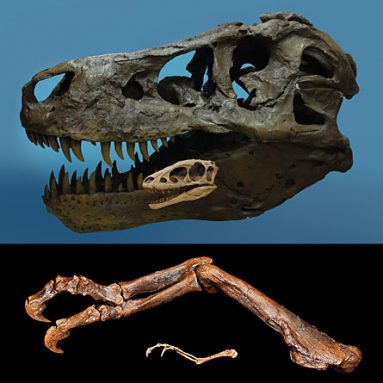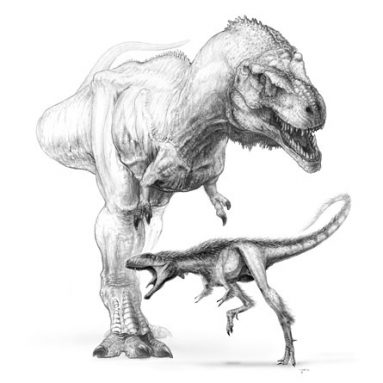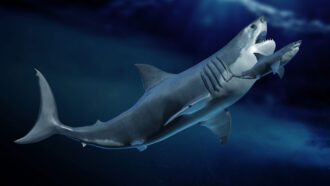Mini T. rex
Scientists have unearthed a dinosaur skeleton that looks like a person-sized Tyrannosaurus rex.
 |
|
Although considerably smaller, the skull and 8-inch-long forelimb of the newly discovered Raptorex share many uncanny features with those of a full-grown Tyrannosaurus rex.
|
| From top: Paul Sereno; Mike Hettwer |
Among dinosaurs, Tyrannosaurus rex may be the most familiar. At 20 feet tall and twice that long from snout to tail, this beast was no doubt a scary sight to any smaller animals that crossed its path. It had a large head, strong legs and tiny arms, and T. rex was one of the fiercest dinosaurs to roam the Earth from about 90 million to 65 million years ago.
A newly found dinosaur skeleton, discovered in China, look a lot like the remains of a T. rex. Its head was large, compared to its body, and its strong legs suggest the animal was quick on its feet. Despite these similarities, there’s a very important difference: This new dinosaur, named Raptorex kriegsteini, was quite a bit smaller than T. rex.
“We see this all to our great surprise in an animal about the size of a human,” says Paul Sereno, a paleontologist at the University of Chicago who led the study of the dino’s bones. (Paleontologists are scientists who study the remains of animals that lived a long time ago to try to understand more about life on Earth.) Sereno and his team of scientists estimate that it would take about 90 full-grown Raptorex dinosaurs to weigh as much as a T. rex.
The scientists were surprised to see so many similarities between the relatively tiny Raptorex and the giant T. rex. In addition to strong legs and a large head, the Raptorex also had specialized feet and tiny arms. The discovery of the Raptorex suggests that paleontologists may have to change the way they think about dinosaur bodies. For example, “It was the common perception that the arms got smaller as the animals grew bigger,” says Sereno. But since the small Raptorex also had tiny arms, that perception may be incorrect—and needs to be studied further.
 |
|
Though only one-ninetieth the size of its descendent Tyrannosaurus rex, the new species Raptorex kriegsteini, shown in an artist’s illustration, had a body plan similar to the king of dinosaurs, with small forelimbs, a massive head and powerful legs
|
| Todd Marshall |
The paleontologists found another important difference between the two types of dinos. The Raptorex dinosaurs probably lived about 125 million years ago, or tens of millions of years before than the first T. rex showed up. This age difference suggests that the evolutionary ancestors of T. rex may also have been fast and fierce—even if they weren’t 20 feet tall.
The paleontologists hope these two differences—skeleton size and time periods—will help them learn how the T. rex evolved through natural selection into a fast and ferocious predator. In the case of the evolution of the T. rex, scientists may want to study how, over time, succeeding generations of the dinosaur evolved to be so large, have such strong legs, or have such tiny arms.
Thomas Holtz, a paleontologist at the University of Maryland in College Park, says the new discovery suggests that the ancestors of T. rex probably looked a lot like the T. rex most people think of today. But, he points out, “There’s still a gap of a few tens of millions of years” that has to be studied. To learn more about how the T. rex came to be so ferocious, however, they’ll have to find the skeletons of dinosaurs that lived in the time between the age of Raptorex and that of T. rex.







